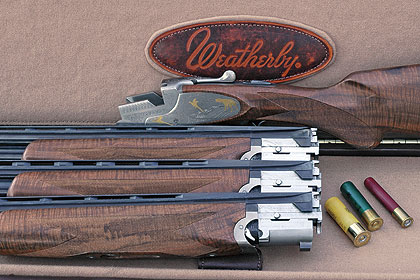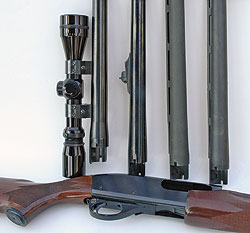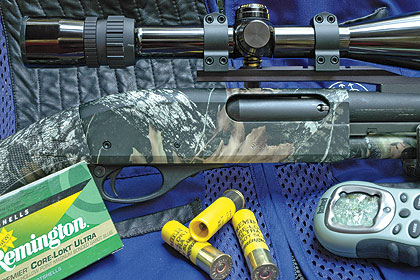By Layne Simpson
I am not sure who originated the idea of a shotgun with interchangeable barrels but if I had to guess I would say it was the English. Several years ago during a visit to the grand old shop of Holland & Holland in London, I examined a side-by-side double with one set of rifled barrels in .450 Nitro Express while the other set was smoothbore in 12 gauge.
 Since these barrel sets in .410, 28 and 20 gauge weigh about the same, the author's Weatherby Athena handles and feels close to the same regardless of which set he is using for hunting. |
Built during the final years of the 19th century for a well-heeled English gentleman who owned a farm in Kenya, it was as suitable for bumping off a marauding bull elephant as for collecting a brace of sand grouse. Holland & Holland and other English firms also made side-by-side shotguns with more than one set of smoothbore barrels.
The first shotgun of American manufacture to be offered with more than one set of barrels was probably the Winchester Model 21. It could be special-ordered with two and even three sets of barrels in the same gauge but of different lengths and choke constrictions. A 20-gauge Grand American shown in Ned Schwing's wonderful book, The Model 21, has three sets of 26-inch barrels with three choke combinations, Skeet 1 and Skeet 2, Improved Cylinder and Modified, and Modified and Full. Barrel sets in various combinations such as .410 and 28 gauge or 20 and 28 gauge were also built by Winchester.
The idea of switching the barrels of shotgun began to gain in popularity by leaps and bounds when various manufacturers of pump and autoloading shotguns began to offer the option. For decades thereafter, hunters and clay target shooters mainly bought additional barrels for those types of guns in order to have different choke constrictions on hand and thousands upon thousands of barrels were sold for just that reason. Then came the universal acceptance of the screw-in choke and while the switch-barrel apple lost some of its shine, it to this day remains entirely practical for other reasons.
One of the reasons we buy extra tubes for our pumps and autoloaders is to have barrels of different lengths. You can get by with shooting ruffed grouse and mourning doves with one barrel of a particular length but some hunters prefer a short barrel when pushing through grouse thickets and a longer barrel for smoother swinging from a duck blind or in a dove field.
 From left to right: a long-eye-relief scope is attached to the rifled slug barrel of this Remington 870; barrel to its right has adjustable open sights and is for Foster-type slugs; two barrels to the right of it are smoothbores used for turkey hunting and wingshooting. |
Multiple Quarry
There are other reasons as well. Thousands of deer are killed by hunters each year with bird guns wearing special slug barrels with adjustable sights and that type of barrel continues to be a good seller. It is available in two styles, smoothbore barrels for use with Foster-type slugs and fully rifled barrels for use with sabot slugs.
One of my Remington 870s is set up specifically for turkey hunting and deer hunting. It has two barrels, a smoothbore for bumping off Thanksgiving dinner and a rifled barrel for harvesting steaks and chops on the hoof. Since that gun has a scope attached to its receiver it is not suitable for wingshooting so there is a better way to go for someone who wants to take birds on the wing and big game with the same gun.
One barrel would be whatever you desire for wingshooting and the other would be a slug barrel with adjustable iron sights or a cantilever-style mount that's permanently attached to the barrel but positions a scope or electronic sight back over the receiver. Hastings also offers a barrel with the scope mount attached further down the barrel but it requires the use of a dot sight or a handgun scope with extra-long eye relief.
Slug barrels with smooth and rifled bores are available from both Hastings and Remington for 870, 1100 and 11-87 shotguns. For shots at deer inside 100 yards, the smoothbore barrel will do fine but for distances on out to 200 yards or so the rifled barrel teamed up with the sabot slug load it prefers will bring home more venison.
 The cantilever-style mount attached to a slug barrel of this Remington 870 positions a scope over the receiver and close to the eye; replacing this barrel with the gun's smoothbore barrel makes it suitable for wingshooting. |
Today, most companies that make over-unders, autoloaders and pump guns offer extra barrels. Fitting an extra set to a double-barrel shotgun has to be done at the factory so buying a gun and having it done later is usually more expensive than buying the same gun with extra barrels to begin with. Pumps and autoloaders are built to much looser tolerances so a trip back to the factory is not required for them.
Skeet Popularity
Back before Briley and others perfected lightweight tubes of smaller gauges that could be inserted into the barrels of 12-gauge over-under shotguns, that type of gun with multiple barrel sets was extremely popular among skeet shooters. Some years back I almost bought a Krieghoff Model 32 with barrels in .410, 12, 20 and 28 gauges but eventually bought one with subgauge tubes instead. An old skeet-shooting friend of mine still owns a very nice Remington 3200 with four sets of barrels.
Barrel sets made for skeet guns were carefully weighted by their manufacturers in an effort to make a gun handle and feel the same regardless of which set of barrels it might be wearing. Despite their efforts, when shooting those two guns I always feel a difference, although less so in the K-32 than in the Model 3200. I can detect very little difference between the 12- and 20-gauge barrels and only a slight difference when switching to the 28-gauge barrels but a switch to the .410 barrels feels like I am shooting an entirely different shotgun.
When shooting smaller gauges on smaller over-under frames, the difference in balance and handling can range from minimal to not at all because you are not going from skinny .410 barrels all the way up to fat 12-gauge barrels. I have a Weatherby Athena with 20-gauge frame and barrels in 20, 28 and .410 on a 20-gauge; when shooting it I have to actually look at its 20- and 28-
gauge barrels to see which it is wearing. I can feel a slight difference in the .410 barrels but it is not enough to affect my shooting. Several years ago on a hunt for bobwhites in South Carolina I used a Beretta with barrels in .410 and 28 on the 28-gauge frame and that gun felt darned close to the same regardless of which of its barrels I was shooting.
So why would anyone want an over-under with more than one set of barrels? One reason is because a gun with three sets of barrels costs much less than three complete guns in the same gauges. This is important to those of us who love to switch back and forth among the various gauges. Sometime back I decided to hunt the grand slam of quail in a single season which consists of bobwhite, Gambel, scaled, Mearns, mountain and the California species.
My initial goal was to take all six with the .410 barrels of my Weatherby switch-barrel gun and thanks to good friends in several states, I managed to accomplish just that. While on those same hunts I decided it would be really neat to repeat the slam with the 28 and 20 gauges as well and having additional barrels for my gun in those gauges added to the fun and enjoyment by making it possible.
A gun with barrels in the smaller gauges is also nice to have on hand when a son or daughter becomes interested in shotgunning. Not all kids enjoy starting with a 20 gauge and even fewer will shoot a 12 gauge more than once but they may just become hooked when shooting Dad's pheasant gun wearing its .410 or 28-gauge barrels.






